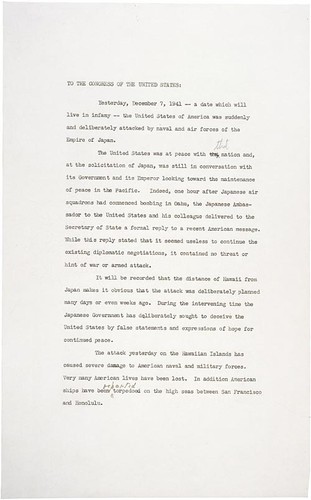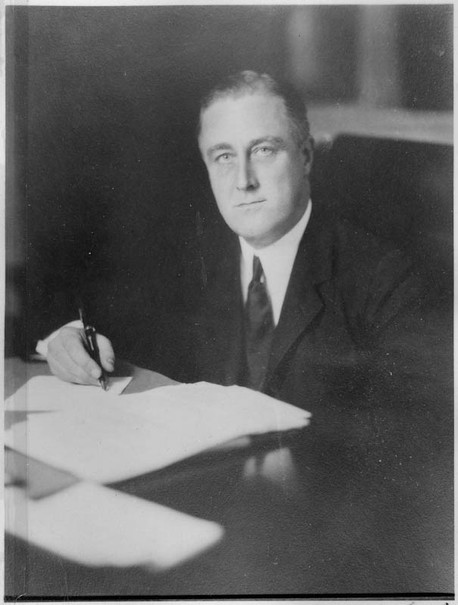President Roosevelt's Declaration of War
Introduction
Text-to-speech Audio
Anti-Japanese bias in the early-1900s United States strained relations between the two nations, leading to devastating consequences in the 1940s. As the Empire of Japan explored imperialism, their disdain for America led to a military attack on Pearl Harbor. The Declaration of War against the Empire of Japan, made by President Franklin D. Roosevelt at the U.S. Capitol, sparked the American people into a wartime fervor.
After the Japanese military attack on Pearl Harbor on December 7, 1941, the Declaration of War against the empire of Japan came swiftly. On December 8, 1941, President Franklin D. Roosevelt declared war on Japan. The United States unified against Japan with amazing speed and worked diligently to secure victory in the war. While such unification assisted with victory, it also led to racially based hatred and suspicion against the Japanese and Japanese Americans throughout the nation. The following years introduced decisions that harmed those of Japanese descent and divided American opinion on the treatment of Japanese Americans in the United States.
Images
"Day of Infamy" Speech - Declaration of War against Japan by President Franklin D. Roosevelt

President Franklin D. Roosevelt

Backstory and Context
Text-to-speech Audio
On December 7, 1941, the Japanese military attack on Pearl Harbor shocked Americans and spurred them into action. As historian Roger Daniels explains,
"the psychological impact of the attack on Pearl Harbor was tremendous...in the ensuing crisis, some of the best and worst instincts of the American people came into play" (Daniels 200-1).
Generalizations and racial distrust erupted immediately upon the outbreak of Pearl Harbor’s attack, reflecting decades of racial discrimination against the Japanese that permeated American society. As historian John Dower explains, “to scores of millions of participants, the war was also a race war...it exposed raw prejudices and was fueled by racial pride, arrogance, and rage on many sides,” just as racial generalizations, perceptions, and hatred directed towards Japan occurred in the United States (Dower 4).
On December 8, 1941, in President Franklin D. Roosevelt’s Declaration of War, he stated that:
"As Commander-in-Chief of the Army and Navy, I have directed that all measures be taken for our defense...No matter how long it may take us to overcome this premeditated invasion, the American people in their righteous might will win through to absolute victory...I asked that the Congress declare that since the unprovoked and dastardly attack by Japan on Sunday, December 7th, 1941, a state of war has existed between the United States and the Japanese Empire" (Roosevelt, December 1941).
Those in attendance met the declaration with raucous applause, and the war between the United States and Japan began.
Sources
Daniels, Roger. Asian America: Chinese and Japanese in the United States Since 1850. Seattle: University of Washington Press, 1988.
Dower, John W. War without Mercy: Race and Power in the Pacific War. Pantheon Books, 1986.
Roosevelt, Franklin D. “President Franklin D. Roosevelt Declares War on Japan.” December 8, 1941. Joint Session of Congress, Washington, D.C. Video, 4:47. https://www.youtube.com/watch?v=lK8gYGg0dkE.
"Day of Infamy" Speech by Franklin D. Roosevelt, December 8, 1941; SEN 77A-H1, Records of the United States Senate; Record Group 46; National Archives.
"Franklin D. Roosevelt formal picture," ID#: 4796901, 1933. Franklin D. Roosevelt Presidential Library & Museum, http://www.fdrlibrary.marist.edu/archives/collections/franklin/index.php?p=digitallibrary/digitalcontent&id=2178
